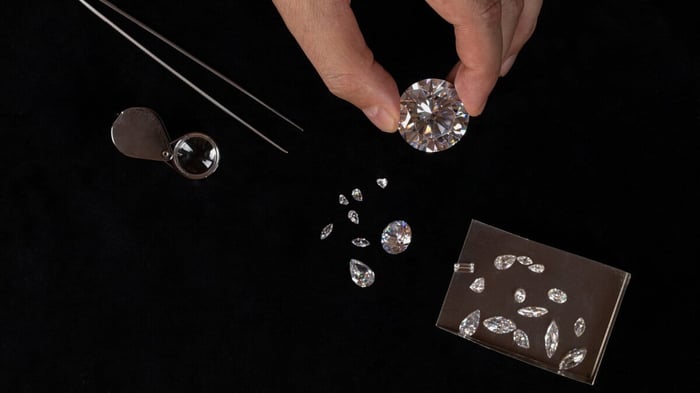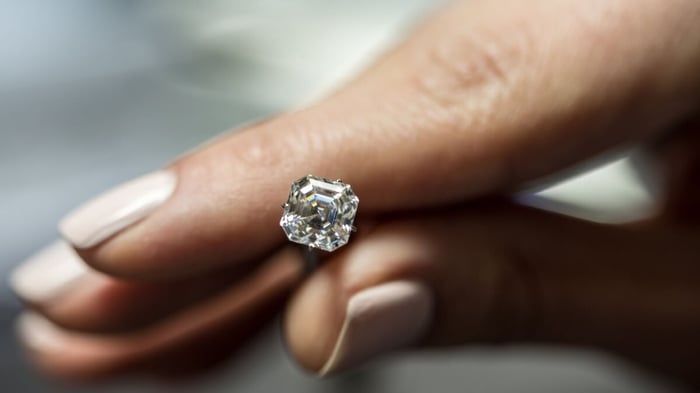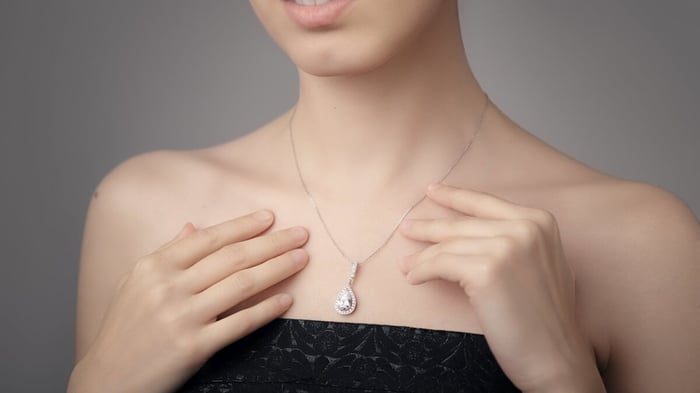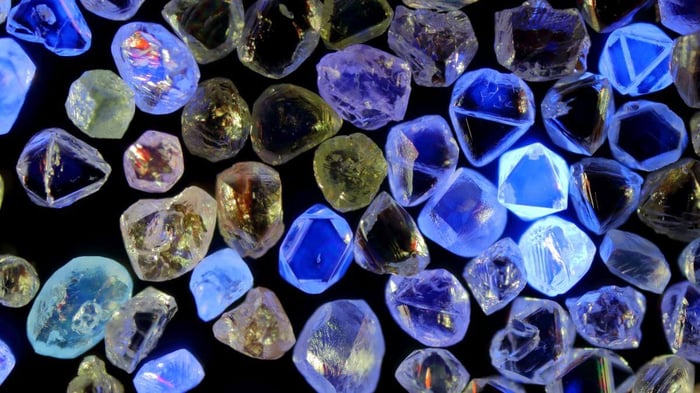These Are The Most Popular Diamond Shapes For Engagement Rings In 2022 and 2023
Buying a diamond engagement ring is one of the most thrilling shopping experiences possible. The search for the perfect engagement ring requires careful consideration of many details. The main diamond's shape is arguably the most crucial for most jewellery buyers. This article will examine the eight most popular diamond shapes for engagement rings.
The round shape remains the most popular, but ending here would result in a very brief article! Other diamond shapes that had fallen out of favour, such as the oval, are making a comeback and displacing other recent favourites. With this comprehensive guide, find out what cuts and shapes will be the most in-demand among engagement ring buyers during 2022 and into 2023.
Read on to discover some valuable pointers about diamond quality and reveal the diamond shapes that are most popular in contemporary diamond engagement rings.
There are a plethora of engagement ring styles and diamond shapes from which to pick. However, styles come and go, so a diamond shape that was in vogue a few years ago may not be the best option for a man shopping for the perfect engagement ring today.
What Factors Should You Think About When You Choose A Diamond For An Engagement Ring?
Learning the "4 Cs" is a necessary first step. Carat weight, cut quality, clarity, and colour are the "Four Cs" of diamond quality. Our blog articles devote considerable space to each of these topics, but here's a quick summary:
Carat: A diamond's weight is expressed in units called carats. One carat weighs approximately 0.2 grams. Bigger is better when it comes to diamonds. The larger the diamond, the more it will cost. However, because larger diamonds are rarer than smaller ones, the price per carat is not directly proportional to the weight.
Colour: Diamonds are given a colour grade from D (colourless) to Z. (a visibly light yellow diamond). Whiter diamonds command a higher price tag. Most buyers prefer whiter diamonds, but few are able to distinguish the difference between a D colour grade diamond and a G colour grade diamond. Still, past that point, the yellowness of the stone will start to become apparent.
Clarity: The number and size of imperfections on a diamond's surface and visible within its interior are measured to determine its clarity. The fewer flaws or inclusions it will have, the higher its clarity grade. A Flawless diamond will have a grading of FL, and A diamond with easily visible flaws and inclusions will have an I grade, possibly with a number indicating its ranking within the I grade; for example, I1, I2 or I3.
Cut: The cut of a diamond is crucial because it determines the stone's symmetry, brilliance, fire, and overall radiance. This grade is an expression of the skill of the artisans working on the diamond. Sometimes, cut quality will be sacrificed in order to minimise diamond wastage during the cutting process, giving a possibly larger diamond than might have otherwise been possible at the price it is sold. Pay careful attention to the cut quality if you see a large diamond sold at a low price.
You can read more about diamond quality in our articles here.
Certified Diamond Solitaire Engagement Ring 0.70ct E/VS Quality in Platinum

£2,561.00
£4,387.00
Light up the eyes of your special someone with a proposal delivered with this gorgeous diamond solitaire ring in spectacular hand-crafted platinum. Start the next chapter of your lives together in style, your love reflected in the unique beauty of… read more
What Is The Difference Between Diamond Cut and Diamond Shapes?
Before going diamond shopping, learning some of the lingo jewellers use to describe the various diamond shapes is important. The distinction between "diamond shape" and "diamond cut" is particularly important. Although they may seem interchangeable at first glance, these terms describe very distinct technical aspects. The problem is made worse by the use of the word “cut” as part of the name of several diamond shapes, as seen in the case of the cushion cut.
When discussing a diamond's shape, jewellers are referring to its overall profile when viewed from above. Frequently seen diamond shapes include the classic round followed by the square, heart, princess, cushion, oval, and others.
On the other hand, a diamond's cut refers to a much narrower set of characteristics than a diamond's shape. A diamond's cut is a term used to describe the way in which the stone's facets are arranged. This arrangement ultimately determines the shape of the stone and its brilliance, scintillation, and dispersion, or "fire." A diamond that has been expertly cut will radiate light and sparkle in black and white, as well as a rainbow of colours. Poorly cut diamonds, by contrast, look dull and lifeless.
Most diamond jewellery buyers will pay more attention to the shape of the diamond than the type or quality of the cut. However, the quality of the cut enables the true beauty of a diamond to sparkle and delight the eyes of any who see them.
The Eight Most Popular Diamond Shapes Of 2022 And 2023
Here are eight diamond shapes ranked in order of their current popularity with buyers of diamond engagement rings.
Round Diamonds
The round, brilliant-cut diamond is the classic diamond shape; its profile seen anywhere is an instant identification with diamonds.
Without a doubt, the round diamond is the most popular choice for engagement rings year after year. This year, just as in every year for decades, round diamonds have been used in more than 50% of engagement rings sold. Because this shape is relatively inefficient to cut, there is a significant degree of wastage. This wastage forces up the price of round diamonds, which usually fetch greater price-per-carat values than other, more efficient shapes.
Certified Round Diamond Engagement & Wedding Ring 0.90ct G/SI 18k Yellow Gold
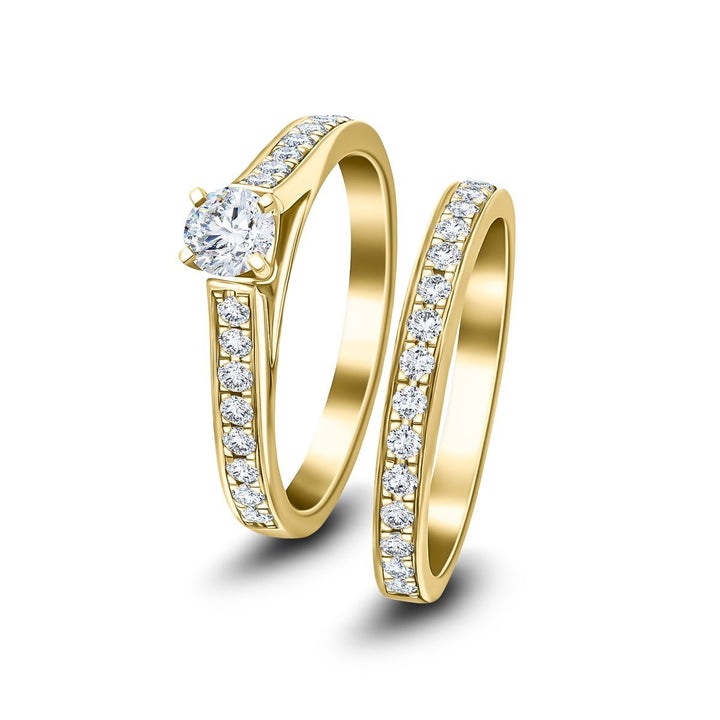
£1,650.00
£2,907.00
Lustrous 18k yellow gold and 0.90 carats of hand-cut G/SI quality diamonds combine in both pieces of this matching wedding and engagement ring bridal set to wonderful effect. With the central stone raised precisely, the engagement ring makes a striking… read more
Princess-Cut Diamonds
The square princess cut is the second most popular diamond shape, after the traditional round brilliant. The princess cut is a relatively new addition to the realm of engagement rings, despite the fact that square diamonds have been around for centuries. However, the number of facets and their arrangement are not agreed upon by all producers and artisans. The lack of standardisation means that buying a princess-cut diamond is a surefire way to buy something that will not be like anyone else’s engagement ring!
One of the reasons why princess cuts are so common is due to their straight sides. This makes it easy to set smaller diamonds as embellishments on either side of the larger centre stone. Princess cuts are less expensive than round brilliants of the same carat and quality because more of the rough diamond crystal is used in the finished princess cut leading to less wastage and a lower cost per carat. In addition, a princess-cut diamond tends to look relatively large for its weight due to the diamond having corners rather than being round.
Emerald Cut Diamonds
Diamond engagement rings often feature square or rectangular gemstones, such as princess cuts or emerald cuts. In contrast to round and princess cuts, Emerald cuts have step-cut facets. Emerald cuts lack the sparkle of rounds, but they have a class all their own with a very different light performance with an understated radiance and shimmer rather than sparkle and fire.
Emerald cuts have less sparkle than other shapes, which may affect your decision to purchase this shape. You can see deeper into the diamond due to the relatively large, flat surfaces. Because of this, cutters have fewer options for covering up unsightly inclusions. Because of this, the clarity grade of the emerald-shaped diamond is more important than more highly faceted shapes. When considering an engagement ring with an emerald-cut diamond, look out for stones free of any imperfections visible to the naked eye. In general, go for VS2 or a higher clarity grade when picking an emerald-cut diamond.
Diamonds cut in emerald shapes are highly valued by jewellers due to their versatility and the elegance they bring to any setting. Emerald cuts can be mounted in a variety of ways, from the geometric Art Deco to vintage, to minimalist modern settings and even very on-trend designs.
Cushion-Cut Diamonds
In terms of shape, the cushion cut is intermediate between the princess cut and the emerald cut. This shape, which was originally conceived in the 18th century, long before automated cutting techniques, can have either a square or a rectangular outline.
Cushions aren't like your regular squares and rectangles with sharp corners and flat sides. Cushion cuts have a gentle profile squarish shape that is reminiscent of a cushion, hence the name. Sometimes they may be advertised as "pillow cuts." Cushions, like other brilliant-cut stones, radiate a lot of light. A well-cut cushion is intended to showcase a diamond's dispersion, or "fire," to its fullest potential. A small cushion diamond may look very similar to a round diamond from above, but the vertical profile is a rather flatter shape than the round, brilliant-cut.
Cushion-shaped diamonds have experienced ebbs and flows of popularity over the past couple of hundred years. Once extremely fashionable, they went out of style during most of the twentieth century. Once thought to be obsolete, cushions have made a comeback in recent years, becoming a trendy, good-value choice for today's engagement rings. Their gentle contours make them the ideal centre stone for those who value elegance without being showy. In the hands of a skilled jeweller, they can be set into marvellous solitaire or stunning halo designs. The latter increases the perceived size and sparkle of the centre stone at a relatively low additional cost.
Asscher-Cut Diamonds
Asscher-cut diamonds offer a more distinctive alternative to traditional square or rectangular shapes. Patented in 1902 by Joseph Asscher, was the first diamond shape to receive a patent. Asscher cuts are distinguished by their long, geometric facets cut into steps and sharply angled, squared-off corners. The result is a neater, sharper style and more up-to-date than cushion cuts.
The clarity grade of an Asscher cut diamond should be carefully considered, just as it is with other step cuts such as emerald-shaped diamonds. Try to find gems with a clarity grade of VS2 or better in order to avoid visible internal imperfections.
Marquise-Cut Diamonds
The marquise cut is another trendy shape that has come and gone over the years. The marquise cut, which first appeared in the middle of the 18th century, is sometimes referred to as a “navette” or little boat. The shape, when viewed from above, reminds viewers of the shape of a small boat. Marquise-shaped diamonds are versatile enough to be used either as the focal point of a solitaire or set with accent stones of various shapes, making them a good choice for a three-stone or halo design.
Since it is so elongated, the marquise cut can be used for a variety of purposes. Try wearing a marquise-cut diamond lengthwise to make a finger look longer and more elegant. However, a marquise worn with the points facing horizontally will give the wearer a more contemporary and daring appearance. If you want to make a bold statement with your diamond, a marquise cut is another excellent choice. Due to their shallow profile and extended length, marquise shape diamonds look larger than other shapes of the same carat weight.
As a result of their distinctive geometric form, symmetry is of the utmost significance. A good marquise will have a symmetrical shape, with the points aligned along a centre line and the sides having the same amount of curvature. If a stone has a dark feature called a "bowtie," which can be seen as the intersection of two dark triangles (the bowties), it is of poor proportion and should be avoided.
A marquise-cut diamond needs care in designing the setting and in daily wear. The pointed ends of the diamond can be chipped and broken unless the stone has well-designed prongs, halo or bezel to protect this relatively fragile area of the stone.
Oval Diamonds
Several high-profile celebrities, including Hailey Bieber and Kourtney Kardashian, have recently been spotted wearing engagement rings featuring oval-shaped brilliant cuts. Identical in outline to marquise-cut stones, ovals differ only in having rounded corners.
There are many similarities between ovals and marquises. Firstly, the slender lines of both are guaranteed to look great on any hand and are especially flattering on shorter fingers, tending to extend the visual length of the wearer’s fingers.
Secondly, ovals and marquises are excellent options if you're shopping for a stone that makes a bold statement. When viewed from above, ovals give the impression of being larger than round diamonds of similar carat weight. Furthermore, ovals place a premium on symmetry and proportion. On the other hand, bowties can also appear in the middle of an oval that is not well proportioned. In contrast to marquises, there are people who appreciate the aesthetic value of bowties in oval diamonds.
Ovals are adaptable when it comes to setting styles. Beautiful solitaire designs are popular and readily available. If you are seeking a more striking ring, you may want to consider more novel approaches, such as setting an oval centre stone with a plethora of smaller stones as side stones in a halo, perhaps set pave style. If you really want to make a statement, have a look at designs with an oval centre stone surrounded by a halo of coloured gemstones.
Pear Halo Diamond Engagement Side Stone Ring 0.35ct G/SI 18k Rose Gold

£789.00
£1,217.00
This elegant diamond engagement ring showcases a halo sparkling round hand-cut diamond nestled in a pear-shaped design to form this magnificent engagement ring. There are additional diamond accents on the shoulders of this ring secured in a claw setting. Sculpted… read more
Pear Diamonds
No list of the most popular diamond shapes for engagement rings in 2022 and beyond would be complete without including the pear shape.
Pears, also known as "teardrops," are an oval and marquise crossover first cut in the 15th century. One end is sharp, and the other is rounded off. Similarly to a marquise or an oval, a pear can enhance the apparent length of a finger. However, the asymmetry of one point and a curve might look off when worn. For this reason, a pear-shaped stone is almost invariably set lengthwise along the finger. The pointed end typically points toward the fingernail.
Select a stone with a silhouette that is similar to the shape of the wearer’s finger to maximize the elongating effects of your pear. If your fingers are on the skinny side, go for a rounder pear, and vice versa if you have wider digits.
The pear shape can be mounted in a variety of ways. If you're looking for something different, try arranging your pears East to West, but expect to have difficulty finding a design with this orientation.
If you want to stand out even more, go with a ring that features a halo around the pear. A central pear can be flanked by smaller stones in a three or five-stone setting.
As with the marquise shape, look out for settings that protect the pointed end of the diamond. A well-positioned prong will usually be adequate, but as with the marquise, a halo or bezel can make for slightly unusual but effective choices.
These vintage-inspired stones, once considered tacky and mocked by Carrie Bradshaw on Sex and the City, are making a comeback and are worthy of your consideration!
The All Diamond Range Of Engagement Rings
All Diamond’s fine jewellery is only available through our online store, where you can browse our collections of diamond engagement rings at leisure and be inspired by the work of our British teams of talented designers and adept artisans.
Our goal is to provide our customers with high-quality jewellery at affordable prices without sacrificing our outstanding service.
You can reach us via the Live Chat widget on each store page. If you have questions about our diamond engagement rings, you can chat with a courteous and expert team member.
